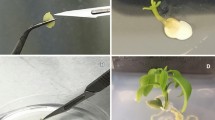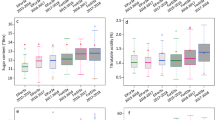Abstract
Seedlessness is one of the most important characteristics for mandarins for the fresh-fruit market, and mandarin triploid hybrids have this trait. Triploid citrus plants can be recovered by 4x × 2x hybridisations using non-apomictic genotypes as female parents. In this study, we characterise the type of seeds obtained in 4x × 2x hybridisations and the ploidy level of plants recovered from each type of seed. The majority of the plants recover were triploid (98.3 %), but a few diploid, tetraploid and pentaploid plants were also produced and their genetic origin was analysed by simple sequence repeat (SSR) markers. We also analysed the influence of parents and environmental conditions on the efficiency of recovery triploid hybrids. In this work, we present an effective methodology to recover triploid hybrids from 4x × 2x hybridisations based on in vitro embryo rescue and determination of ploidy level by flow cytometry that allow us to recover more than 4,400 triploid hybrids from more than 60 parental combinations.









Similar content being viewed by others
References
Aleza P, Juárez J, Hernández M, Pina JA, Ollitrault P, Navarro L (2009a) Recovery and characterization of a Citrus clementina Hort. ex Tan. ‘Clemenules’ haploid plant selected to establish the reference whole Citrus genome sequence. BMC Plant Biol 9:110
Aleza P, Juárez J, Ollitrault P, Navarro L (2009b) Production of tetraploid plants of non apomictic citrus genotypes. Plant Cell Rep 28:1837–1846
Aleza P, Juárez J, Cuenca J, Ollitrault P, Navarro L (2010) Recovery of citrus triploid hybrids by embryo rescue and flow cytometry from 2x × 2x sexual hybridisation and its application to extensive breeding programs. Plant Cell Rep 29:1023–1034
Aleza P, Froelicher Y, Schwarz S, Hernández M, Juárez J, Morillon R, Navarro L, Ollitrault P (2011) Tetraploidization events by chromosome doubling of nucellar cells are frequent in apomictic citrus and are dependant of genotype and environment. Ann Bot 108:37–50
Bono R, Soler J, Buj A, Villalba D, Salvia J, Bellver R, Mares M, Méndez JV, Gavilá L (2006) El problema de la presencia de semillas en los frutos cítricos. Conselleria de Agricultura Pesca y Alimentación, Ficha Técnica serie citricultura Nº 5
Cameron JW, Burnett RH (1978) Use of sexual tetraploid seed parents for production of triploid citrus hybrids. HortSci 13:167–169
Cameron JW, Frost HB (1968) Genetic, breeding and nucellar embryony. In: Reuther W, Batchelor LD, Webber HJ (eds) The Citrus Industry, vol 1. University of California, Riverside, pp 325–370
Cuenca J, Froelicher Y, Aleza P, Juárez J, Navarro L, Ollitrault P (2011) Multilocus half tetrad analysis and centromere mapping in Citrus; evidences of SDR mechanism for 2n megagametophyte production and partial chromosome interference in mandarin cv Fortune. Heredity 107(5):462–470
Dellaporta J, Hicks JB (1983) A plant DNA minipreparation: version II. Plant Mol Biol Report 1:19–21
Elgersma A, Stephenson AG, Nijs APM (1989) Effects of genotype and temperature on pollen tube growth in perennial ryegrass (Lolium perenne L.). Sex Plant Reprod 2:225–230
Esen A, Soost RK (1971a) Unexpected triploids in citrus: their origin, identification and possible use. J Hered 62:329–333
Esen A, Soost RK (1971b) Tetraploid progenies from 2x–4x crosses of Citrus and their origin. J Am Soc Hortic Sci 97:410–414
Esen A, Soost RK (1973) Precocious development and germination of spontaneous triploid seeds in Citrus. J Hered 64:147–154
Esen A, Soost RK, Geraci G (1978) Seed set, size and development after 4x–2x and 4x–4x crosses in Citrus. Euphytica 27:283–293
Esselink GD, Nybom H, Vosman B (2004) Assignment of allelic configuration in polyploids using the MAC-PR (microsatellite DNA allele counting—peak ratios) method. Theor Appl Genet 109:402–408
Fatta Del Bosco S, Matranga G, Geraci G (1992) Micro and macro-sporogenesis of two triploid hybrids of Citrus. In: Proceedings of 7th International Citrus Congress. International Society of Citriculture, Acireale, Italy. 1:122–124
Froelicher Y, Bassene JB, JedidI-Neji E, Morillon R, Bernardini G, Costantino G, Ollitrault P (2007) Induced parthenogenesis in mandarin: induction procedures and genetic analysis of plantlets. Plant Cell Rep 26(7):937–944
Froelicher Y, Dambier D, Bassene JB, Costantino G, Lotfy S, Didout C, Beaumont V, Brottier P, Risterucci AM, Luro F, Ollitrault P (2008) Characterization of microsatellite markers in mandarin orange (Citrus reticulata Blanco). Mol Ecol Resour 8(1):119–122
Frost HB (1943) Genetics and breeding. In: Webber HJ, Batchelor LD (eds) The Citrus Industry, vol I. University of California, Riverside, pp 817–913
Frost HB, Soost RK (1968) Seed reproduction: development of gametes and embryos. In: Reuther W, Batchelor LD, Webber HB (eds) The Citrus Industry, vol 2. University of California, Barkley, USA, pp 290–324
Geraci G, Esen A, Soost RK (1975) Triploid progenies from 2x–2x crosses of Citrus cultivars. J Hered 66:177–178
Germanà MA, Chiancone B (2001) Gynogenetic haploids of Citrus after in vitro pollination with triploid pollen grains. Plant Cell Tissue Organ Cult 66:59–66
Grosser WJ, Gmitter FG (2011) Protoplast fusion for production of tetraploids and triploids: applications for scion and rootstock breeding in citrus. Plant Cell Tissue Organ Cult 104:343–357
Jefferies CJ, Brain P, Stott KG, Belcher AR (1982) Experimental systems and mathematical model for studying temperature effects on pollen-tube growth and fertilization in plum. Plant Cell Environ 5:231–236
Jóhannsson MH, Stephenson AG (1998) Effects of temperature during microsporogenesis on pollen performance in Cucurbita pepo L. (Cucurbitaceae). Int J Plant Sci 159:616–626
Kamiri M, Stift M, Srairi I, Costantino G, El Moussadik A, Hmyene A, Bakry F, Ollitrault P, Froelicher Y (2011) Evidence for non-disomic inheritance in a Citrus interspecific tetraploid somatic between C. reticulata and C. lemon hybrid using SSR markers and cytogenetic analysis. Plant Cell Rep 30:1415–1425
Kijas JMH, Thomas MR, Fowler JCS, Roose ML (1997) Integration of trinucleotide microsatellites into a linkage map of Citrus. Theor Appl Genet 94:701–706
Koltunow AM (1993) Apomixis: embryo sacs and embryos formed without meiosis or fertilization in ovules. Plant Cell 5:1425–1437
Lewis D (1942) The physiology of incompatibility in plants. I. Effect of temperature. Proc R Soc London Ser B Biol Sci 131:13–26
Luro F, Maddy F, Jacquemond C, Froelicher Y, Morillon R, Rist D, Ollitrault P (2004) Identification and evaluation of diplogyny in clementine (Citrus clementina) for use in breeding. In: XI Eucarpia Symposium on Fruit Breeding and Genetics. Acta Horticulturae 663:841–847
Murashige T, Skoog F (1962) A revised medium for rapid growth and bioassays with tobacco tissue cultures. Physiol Plant 15:473–479
Navarro L, Juárez J (2007) Shoot-tip grafting in vitro. In: Khan IA (ed) Citrus genetics, breeding and biotechnology. CABI Head Office, Wallingford, pp 353–364
Navarro L, Juárez J, Aleza P, Pina JA (2002a) Recovery of triploid seedless mandarin hybrids from 2n × 2n and 2n × 4n crosses by embryo rescue and flow cytometry. In: Proceedings of the 10th IAPTC&B Congress, Plant Biotechnology 2002 and Beyond. Orlando, Florida, USA, pp. 541–544
Navarro L, Pina JA, Juárez J, Ballester-Olmos JF, Arregui JM, Ortega C, Navarro A, Duran-Vila, N, Guerri J, Moreno P, Cambra M, Zaragoza S (2002b) The citrus variety improvement program in Spain in the period 1975–2001. In: Proceedings of the 15th Conf. Intern. Organization Citrus Virol., IOCV, Riverside, pp. 306–316
Navarro L, Juárez J, Aleza P, Pina JA, Olivares-Fuster O, Cuenca J, Julve JM (2005) Programa de obtención de híbridos triploides de mandarino en España. Phytoma 170:36–41
Oiyama I, Kobayashi S (1991) Citrus pentaploids from small seeds of diploid × diploid crosses. HortSci 26(3):292–293
Oiyama I, Kobayashi S (1993) Haploids obtained from diploid × triploid crosses of citrus. J Jpn Soc Hortic Sci 62:89–93
Ollitrault P, Michaux-Ferriere N (1992) Application of flow cytometry for citrus genetic and breeding. In: Proceeding of the 7th International Citrus Congress, International Society of Citriculture, Acireale, Italy. 1:193–198
Ollitrault P, Dambier D, Allent V, Luro F, Jacquemond C (1996) In vitro embryo rescue and selection of spontaneous triploid by flow cytometry for easy peeler citrus breeding. In: Proceeding of the 8th Citrus International Congress. International Society of Citriculture. Sun City, South Africa. 1:254–258
Ollitrault P, Dambier D, Luro F, Froelicher Y (2008) Ploidy manipulation for breeding seedless triploid citrus. Plant Breed Rev 20:323–354
Otto SP, Whitton J (2000) Polyploid incidence and evolution. Annu Rev Genet 34:401–437
Shivanna KR, Linskens HF, Cresti M (1991) Response of tobacco pollen to high humidity and heat stress: viability and germinability in vitro and in vivo. Sex Plant Reprod 4:104–109
Starrantino A, Recupero G (1981) Citrus hybrids obtained in vitro from 2x females X 4x males. In: Proceedings 4th International Citrus Congress. International Society of Citriculture, Tokyo, Japan. 1:31–32
Stephenson AG, Lau TC, Quesada M, Winsor JA (1992) Factors that affect pollen performance. In: Wyatt R (ed) Ecology and evolution of plant reproduction. Chapman & Hall, New York, pp 119–134
Toolapong P, Komatsu H, Iwamasa M (1996) Triploids and haploid progenies derived from small seeds of ‘Banpeiyu’ pummelo, crossed with ‘Ruby Red’ grapefruit. J Jpn Soc Hortic Sci 65:255–260
Viloria Z, Grosser JW (2005) Acid citrus fruit improvement via interploid hybridization using allotetraploid somatic hybrid and autotetraploid breeding parents. J Am Soc Hortic Sci 130(3):392–402
Wakana A, Uemoto S (1987) Adventive embryogenesis in citrus I. The occurrence of adventive embryos without pollination or fertilization. Am J Bot 74:517–530
Williams TE, Roose ML (2004) ‘TDE2’ Mandarin hybrid (Shasta Gold® Mandarin), ‘TDE3’ Mandarin hybrid (Tahoe Gold® Mandarin) and ‘TDE4’ Mandarin hybrid (Yosemite Gold® Mandarin): Three New Mid and Late-Season Triploid Seedless Mandarin Hybrids from California. In: Proceedings of 10th International Citrus Congress. International Society of Citriculture. Agadir, Marruecos, 1:394–398
Young HJ, Stanton ML (1990) Influence of environmental quality on pollen competitive ability in wild radish. Science 248:1631–1633
Acknowledgements
We thank J.M. Arregui, C. Ortega, A. Navarro, V. Ortega, and C. Martí for their technical assistance in the laboratory, and J.A. Pina, V. Lloris, J.M. Conchilla, F. Ahuir, D. Conchilla, A. Conchilla, R. López, and F.J. Martí for growing plants in the greenhouse and in the field. We also thank Dr. F. Luro from INRA (France) for providing unpublished SSRs markers. This work was supported by a grant (Prometeo/2008/121) from the Generalitat Valenciana, Spain and by a grant (AGL2008-00596) from the Ministry of Science and Innovation of Spain-Fondo Europeo de Desarrollo Regional (FEDER).
Author information
Authors and Affiliations
Corresponding authors
Additional information
Communicated by A. Dandekar
Rights and permissions
About this article
Cite this article
Aleza, P., Juárez, J., Hernández, M. et al. Implementation of extensive citrus triploid breeding programs based on 4x × 2x sexual hybridisations. Tree Genetics & Genomes 8, 1293–1306 (2012). https://doi.org/10.1007/s11295-012-0515-6
Received:
Revised:
Accepted:
Published:
Issue Date:
DOI: https://doi.org/10.1007/s11295-012-0515-6




